Ratio Analysis of J Sainsbury Plc for 2018-2020
VerifiedAdded on 2023/01/11
|10
|1330
|58
AI Summary
This document provides a detailed analysis of the financial ratios of J Sainsbury Plc for the years 2018, 2019, and 2020. It covers liquidity ratios, profitability ratios, efficiency ratios, and solvency ratios. The data obtained from the analysis is useful for operational and strategic decision-making.
Contribute Materials
Your contribution can guide someone’s learning journey. Share your
documents today.
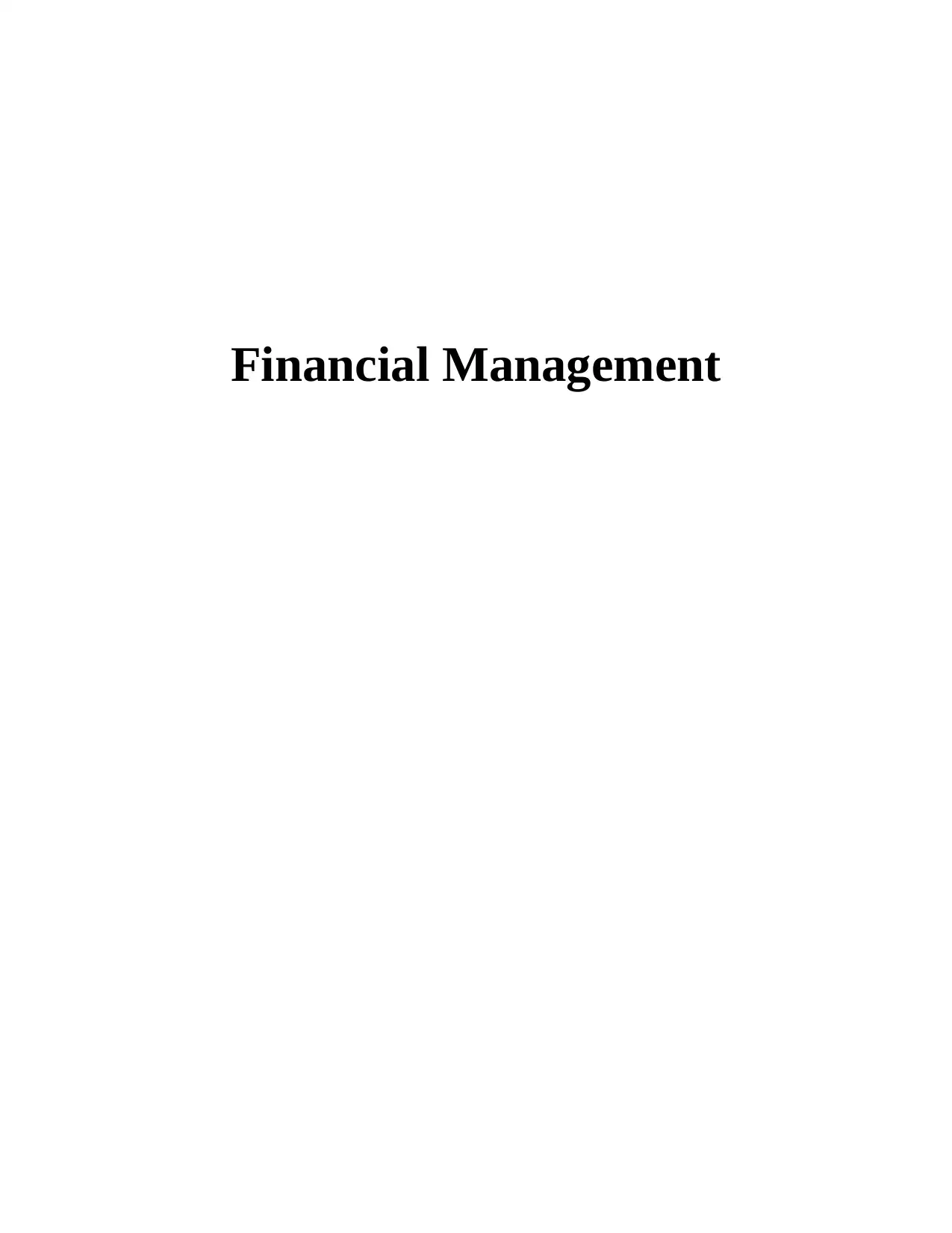
Financial Management
Secure Best Marks with AI Grader
Need help grading? Try our AI Grader for instant feedback on your assignments.
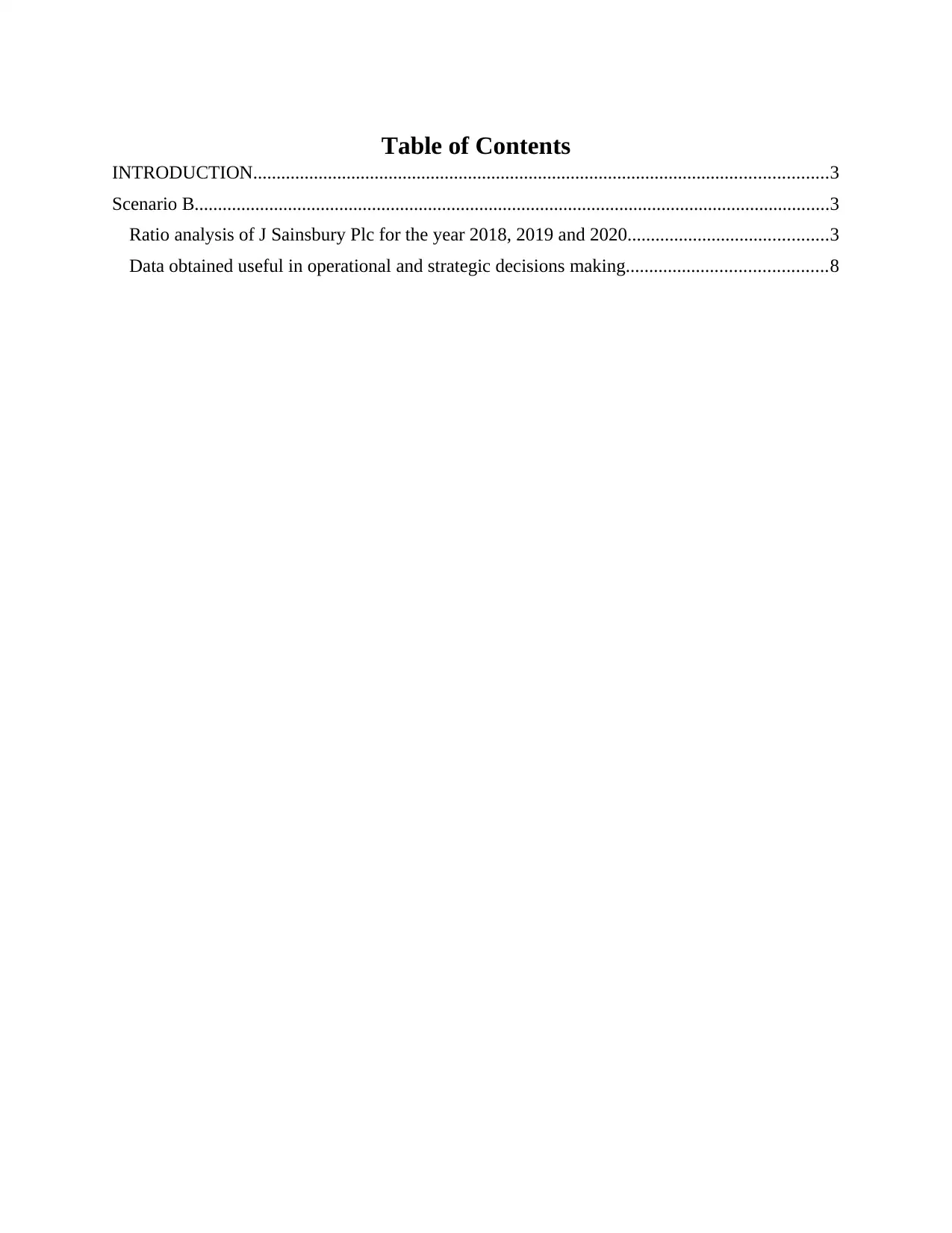
Table of Contents
INTRODUCTION...........................................................................................................................3
Scenario B........................................................................................................................................3
Ratio analysis of J Sainsbury Plc for the year 2018, 2019 and 2020...........................................3
Data obtained useful in operational and strategic decisions making...........................................8
INTRODUCTION...........................................................................................................................3
Scenario B........................................................................................................................................3
Ratio analysis of J Sainsbury Plc for the year 2018, 2019 and 2020...........................................3
Data obtained useful in operational and strategic decisions making...........................................8
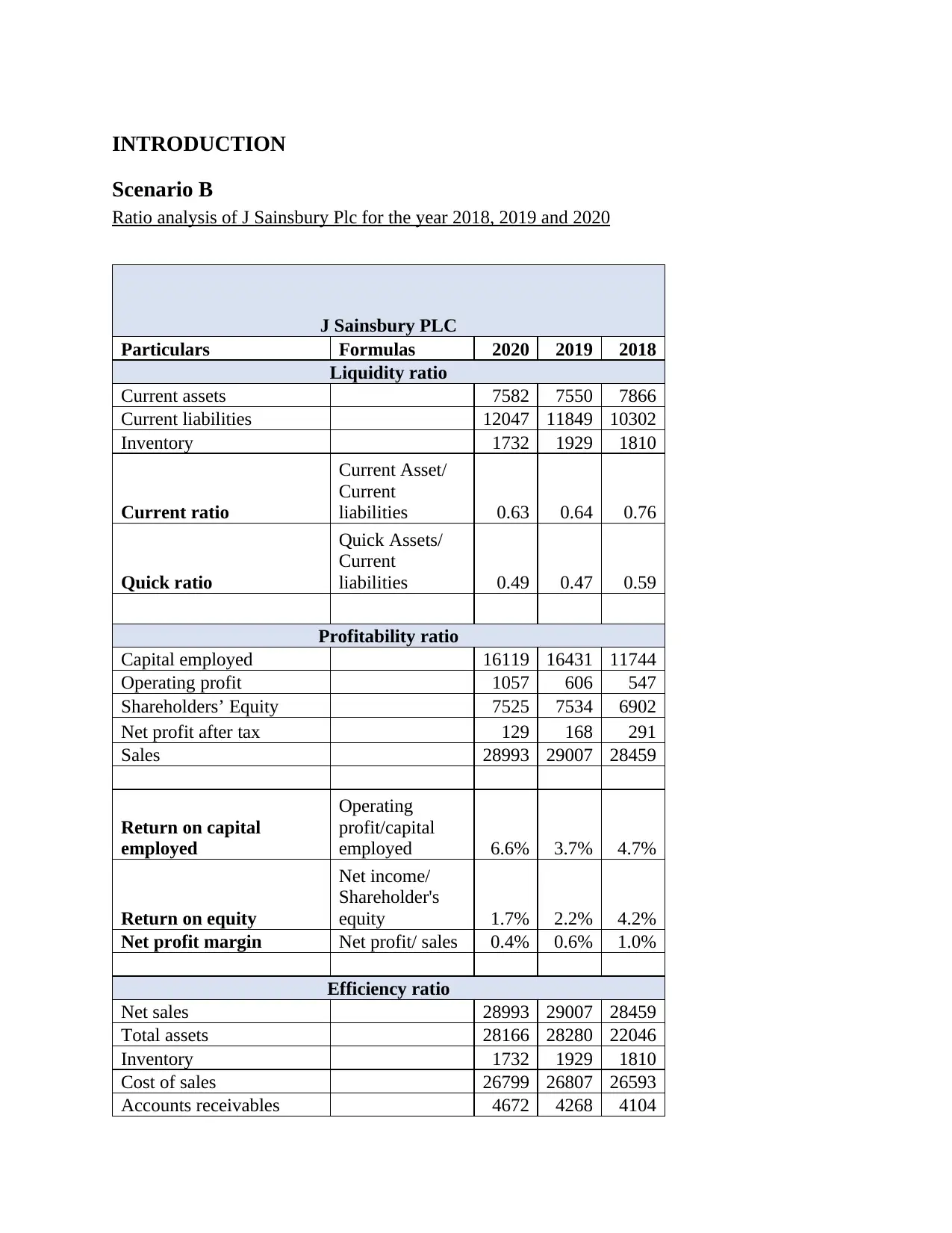
INTRODUCTION
Scenario B
Ratio analysis of J Sainsbury Plc for the year 2018, 2019 and 2020
J Sainsbury PLC
Particulars Formulas 2020 2019 2018
Liquidity ratio
Current assets 7582 7550 7866
Current liabilities 12047 11849 10302
Inventory 1732 1929 1810
Current ratio
Current Asset/
Current
liabilities 0.63 0.64 0.76
Quick ratio
Quick Assets/
Current
liabilities 0.49 0.47 0.59
Profitability ratio
Capital employed 16119 16431 11744
Operating profit 1057 606 547
Shareholders’ Equity 7525 7534 6902
Net profit after tax 129 168 291
Sales 28993 29007 28459
Return on capital
employed
Operating
profit/capital
employed 6.6% 3.7% 4.7%
Return on equity
Net income/
Shareholder's
equity 1.7% 2.2% 4.2%
Net profit margin Net profit/ sales 0.4% 0.6% 1.0%
Efficiency ratio
Net sales 28993 29007 28459
Total assets 28166 28280 22046
Inventory 1732 1929 1810
Cost of sales 26799 26807 26593
Accounts receivables 4672 4268 4104
Scenario B
Ratio analysis of J Sainsbury Plc for the year 2018, 2019 and 2020
J Sainsbury PLC
Particulars Formulas 2020 2019 2018
Liquidity ratio
Current assets 7582 7550 7866
Current liabilities 12047 11849 10302
Inventory 1732 1929 1810
Current ratio
Current Asset/
Current
liabilities 0.63 0.64 0.76
Quick ratio
Quick Assets/
Current
liabilities 0.49 0.47 0.59
Profitability ratio
Capital employed 16119 16431 11744
Operating profit 1057 606 547
Shareholders’ Equity 7525 7534 6902
Net profit after tax 129 168 291
Sales 28993 29007 28459
Return on capital
employed
Operating
profit/capital
employed 6.6% 3.7% 4.7%
Return on equity
Net income/
Shareholder's
equity 1.7% 2.2% 4.2%
Net profit margin Net profit/ sales 0.4% 0.6% 1.0%
Efficiency ratio
Net sales 28993 29007 28459
Total assets 28166 28280 22046
Inventory 1732 1929 1810
Cost of sales 26799 26807 26593
Accounts receivables 4672 4268 4104
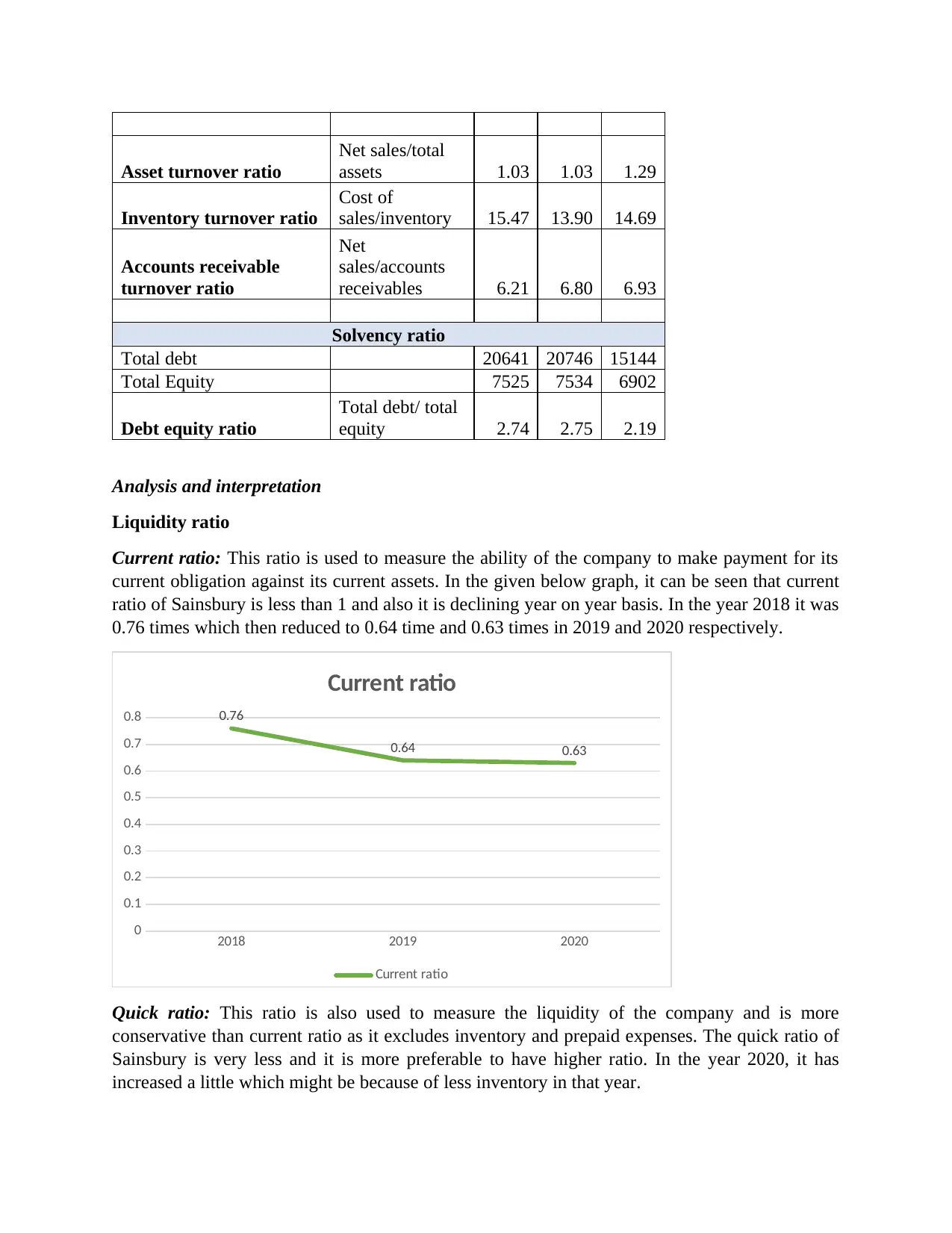
Asset turnover ratio
Net sales/total
assets 1.03 1.03 1.29
Inventory turnover ratio
Cost of
sales/inventory 15.47 13.90 14.69
Accounts receivable
turnover ratio
Net
sales/accounts
receivables 6.21 6.80 6.93
Solvency ratio
Total debt 20641 20746 15144
Total Equity 7525 7534 6902
Debt equity ratio
Total debt/ total
equity 2.74 2.75 2.19
Analysis and interpretation
Liquidity ratio
Current ratio: This ratio is used to measure the ability of the company to make payment for its
current obligation against its current assets. In the given below graph, it can be seen that current
ratio of Sainsbury is less than 1 and also it is declining year on year basis. In the year 2018 it was
0.76 times which then reduced to 0.64 time and 0.63 times in 2019 and 2020 respectively.
2018 2019 2020
0
0.1
0.2
0.3
0.4
0.5
0.6
0.7
0.8 0.76
0.64 0.63
Current ratio
Current ratio
Quick ratio: This ratio is also used to measure the liquidity of the company and is more
conservative than current ratio as it excludes inventory and prepaid expenses. The quick ratio of
Sainsbury is very less and it is more preferable to have higher ratio. In the year 2020, it has
increased a little which might be because of less inventory in that year.
Net sales/total
assets 1.03 1.03 1.29
Inventory turnover ratio
Cost of
sales/inventory 15.47 13.90 14.69
Accounts receivable
turnover ratio
Net
sales/accounts
receivables 6.21 6.80 6.93
Solvency ratio
Total debt 20641 20746 15144
Total Equity 7525 7534 6902
Debt equity ratio
Total debt/ total
equity 2.74 2.75 2.19
Analysis and interpretation
Liquidity ratio
Current ratio: This ratio is used to measure the ability of the company to make payment for its
current obligation against its current assets. In the given below graph, it can be seen that current
ratio of Sainsbury is less than 1 and also it is declining year on year basis. In the year 2018 it was
0.76 times which then reduced to 0.64 time and 0.63 times in 2019 and 2020 respectively.
2018 2019 2020
0
0.1
0.2
0.3
0.4
0.5
0.6
0.7
0.8 0.76
0.64 0.63
Current ratio
Current ratio
Quick ratio: This ratio is also used to measure the liquidity of the company and is more
conservative than current ratio as it excludes inventory and prepaid expenses. The quick ratio of
Sainsbury is very less and it is more preferable to have higher ratio. In the year 2020, it has
increased a little which might be because of less inventory in that year.
Secure Best Marks with AI Grader
Need help grading? Try our AI Grader for instant feedback on your assignments.
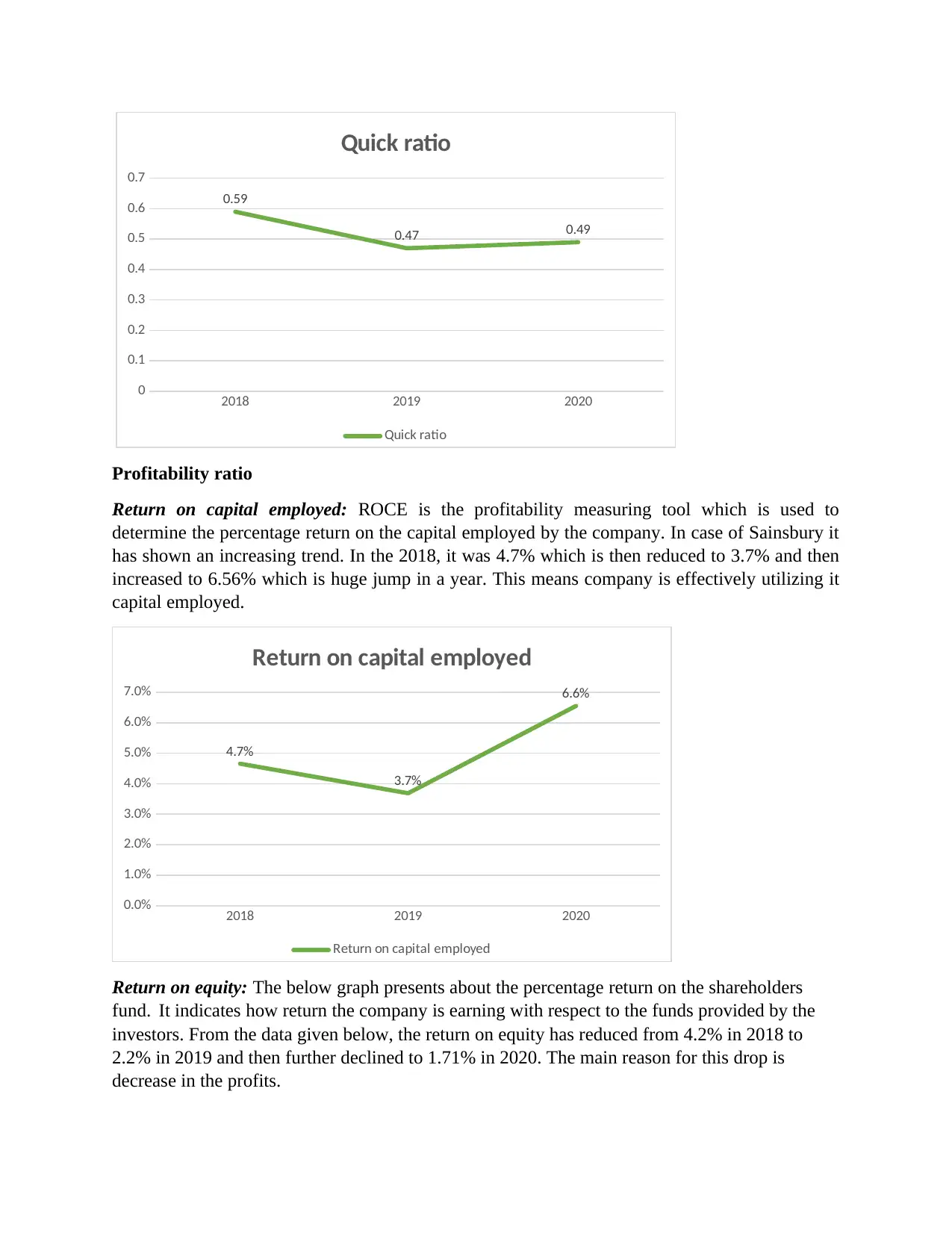
2018 2019 2020
0
0.1
0.2
0.3
0.4
0.5
0.6
0.7
0.59
0.47 0.49
Quick ratio
Quick ratio
Profitability ratio
Return on capital employed: ROCE is the profitability measuring tool which is used to
determine the percentage return on the capital employed by the company. In case of Sainsbury it
has shown an increasing trend. In the 2018, it was 4.7% which is then reduced to 3.7% and then
increased to 6.56% which is huge jump in a year. This means company is effectively utilizing it
capital employed.
2018 2019 2020
0.0%
1.0%
2.0%
3.0%
4.0%
5.0%
6.0%
7.0%
4.7%
3.7%
6.6%
Return on capital employed
Return on capital employed
Return on equity: The below graph presents about the percentage return on the shareholders
fund. It indicates how return the company is earning with respect to the funds provided by the
investors. From the data given below, the return on equity has reduced from 4.2% in 2018 to
2.2% in 2019 and then further declined to 1.71% in 2020. The main reason for this drop is
decrease in the profits.
0
0.1
0.2
0.3
0.4
0.5
0.6
0.7
0.59
0.47 0.49
Quick ratio
Quick ratio
Profitability ratio
Return on capital employed: ROCE is the profitability measuring tool which is used to
determine the percentage return on the capital employed by the company. In case of Sainsbury it
has shown an increasing trend. In the 2018, it was 4.7% which is then reduced to 3.7% and then
increased to 6.56% which is huge jump in a year. This means company is effectively utilizing it
capital employed.
2018 2019 2020
0.0%
1.0%
2.0%
3.0%
4.0%
5.0%
6.0%
7.0%
4.7%
3.7%
6.6%
Return on capital employed
Return on capital employed
Return on equity: The below graph presents about the percentage return on the shareholders
fund. It indicates how return the company is earning with respect to the funds provided by the
investors. From the data given below, the return on equity has reduced from 4.2% in 2018 to
2.2% in 2019 and then further declined to 1.71% in 2020. The main reason for this drop is
decrease in the profits.
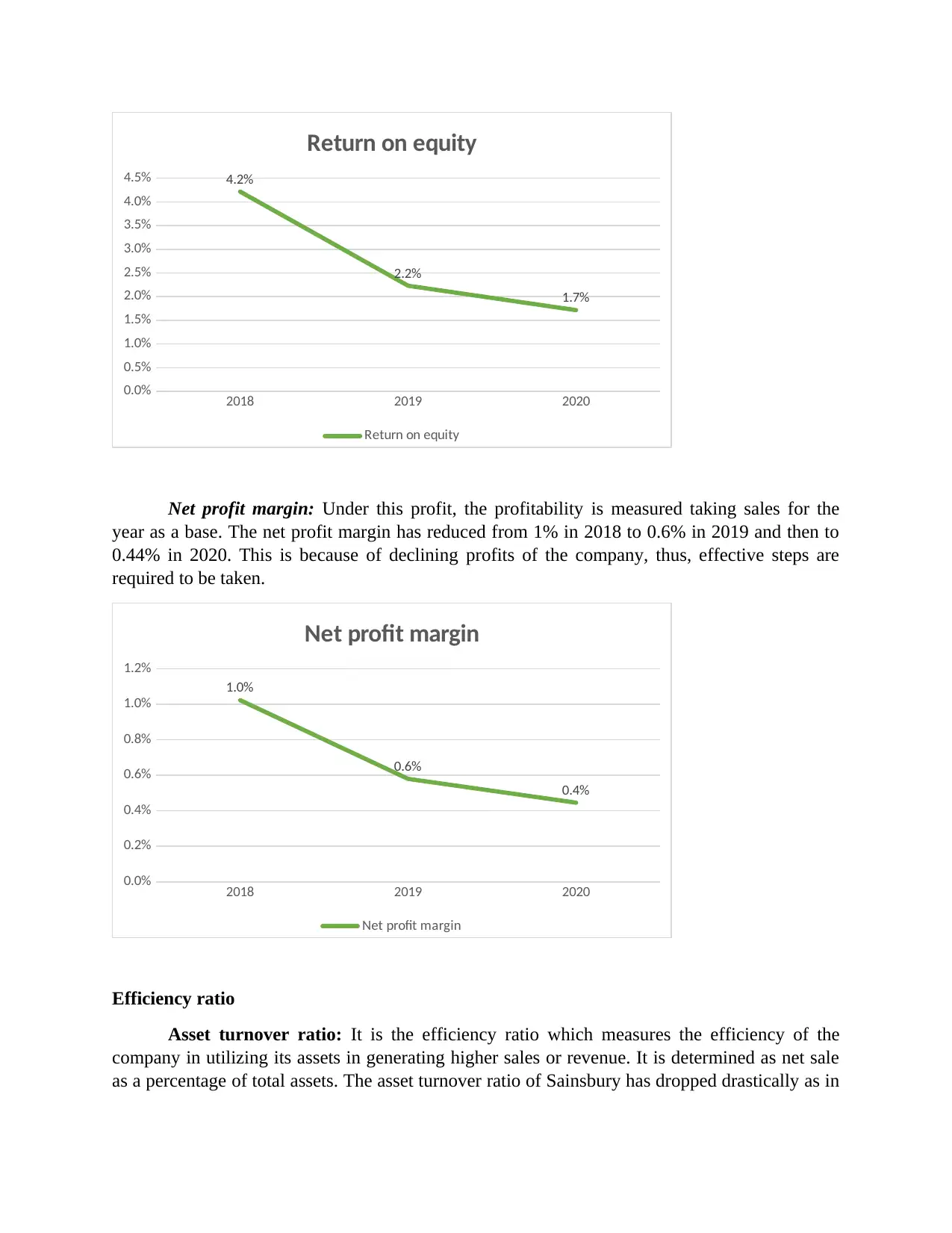
2018 2019 2020
0.0%
0.5%
1.0%
1.5%
2.0%
2.5%
3.0%
3.5%
4.0%
4.5% 4.2%
2.2%
1.7%
Return on equity
Return on equity
Net profit margin: Under this profit, the profitability is measured taking sales for the
year as a base. The net profit margin has reduced from 1% in 2018 to 0.6% in 2019 and then to
0.44% in 2020. This is because of declining profits of the company, thus, effective steps are
required to be taken.
2018 2019 2020
0.0%
0.2%
0.4%
0.6%
0.8%
1.0%
1.2%
1.0%
0.6%
0.4%
Net profit margin
Net profit margin
Efficiency ratio
Asset turnover ratio: It is the efficiency ratio which measures the efficiency of the
company in utilizing its assets in generating higher sales or revenue. It is determined as net sale
as a percentage of total assets. The asset turnover ratio of Sainsbury has dropped drastically as in
0.0%
0.5%
1.0%
1.5%
2.0%
2.5%
3.0%
3.5%
4.0%
4.5% 4.2%
2.2%
1.7%
Return on equity
Return on equity
Net profit margin: Under this profit, the profitability is measured taking sales for the
year as a base. The net profit margin has reduced from 1% in 2018 to 0.6% in 2019 and then to
0.44% in 2020. This is because of declining profits of the company, thus, effective steps are
required to be taken.
2018 2019 2020
0.0%
0.2%
0.4%
0.6%
0.8%
1.0%
1.2%
1.0%
0.6%
0.4%
Net profit margin
Net profit margin
Efficiency ratio
Asset turnover ratio: It is the efficiency ratio which measures the efficiency of the
company in utilizing its assets in generating higher sales or revenue. It is determined as net sale
as a percentage of total assets. The asset turnover ratio of Sainsbury has dropped drastically as in
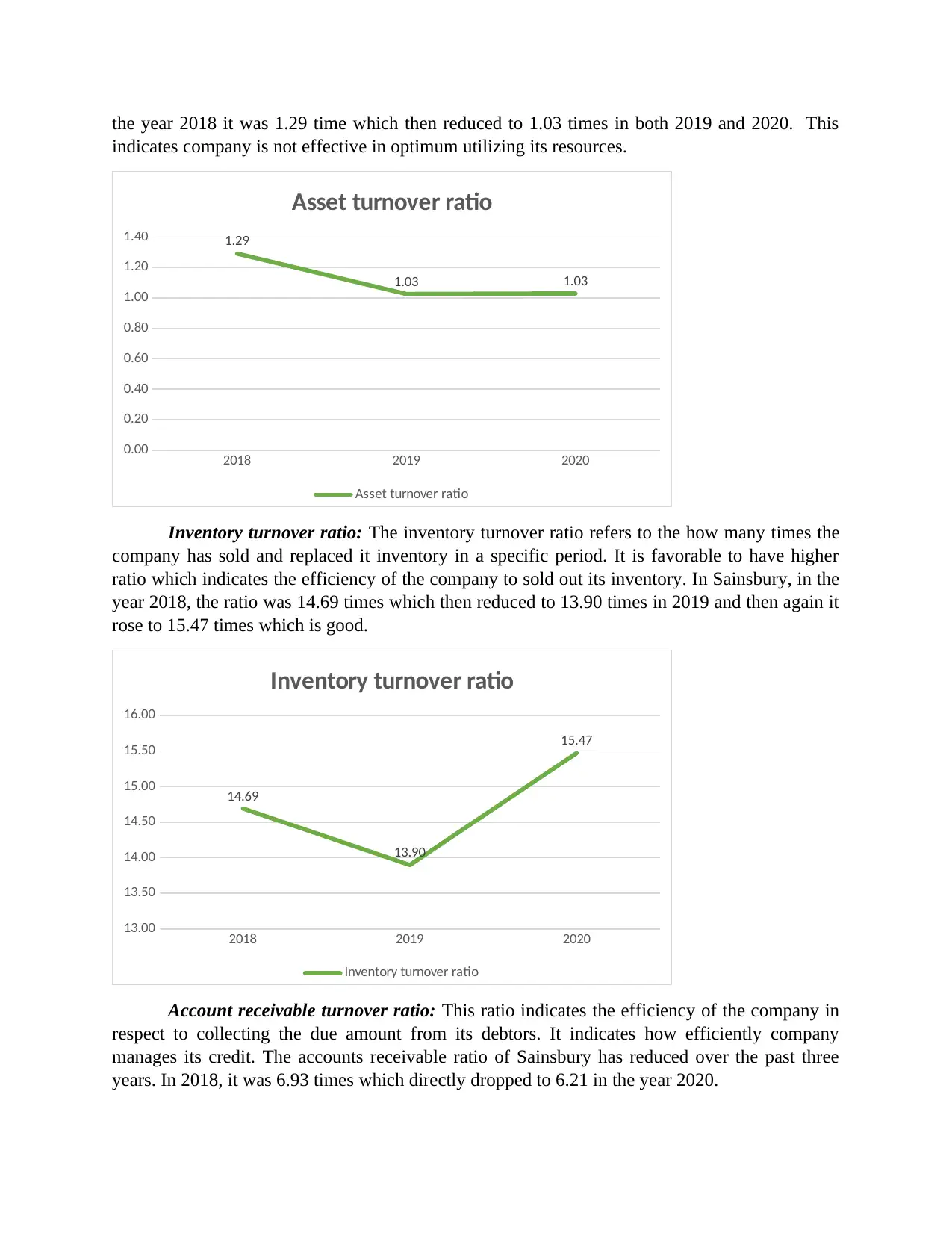
the year 2018 it was 1.29 time which then reduced to 1.03 times in both 2019 and 2020. This
indicates company is not effective in optimum utilizing its resources.
2018 2019 2020
0.00
0.20
0.40
0.60
0.80
1.00
1.20
1.40 1.29
1.03 1.03
Asset turnover ratio
Asset turnover ratio
Inventory turnover ratio: The inventory turnover ratio refers to the how many times the
company has sold and replaced it inventory in a specific period. It is favorable to have higher
ratio which indicates the efficiency of the company to sold out its inventory. In Sainsbury, in the
year 2018, the ratio was 14.69 times which then reduced to 13.90 times in 2019 and then again it
rose to 15.47 times which is good.
2018 2019 2020
13.00
13.50
14.00
14.50
15.00
15.50
16.00
14.69
13.90
15.47
Inventory turnover ratio
Inventory turnover ratio
Account receivable turnover ratio: This ratio indicates the efficiency of the company in
respect to collecting the due amount from its debtors. It indicates how efficiently company
manages its credit. The accounts receivable ratio of Sainsbury has reduced over the past three
years. In 2018, it was 6.93 times which directly dropped to 6.21 in the year 2020.
indicates company is not effective in optimum utilizing its resources.
2018 2019 2020
0.00
0.20
0.40
0.60
0.80
1.00
1.20
1.40 1.29
1.03 1.03
Asset turnover ratio
Asset turnover ratio
Inventory turnover ratio: The inventory turnover ratio refers to the how many times the
company has sold and replaced it inventory in a specific period. It is favorable to have higher
ratio which indicates the efficiency of the company to sold out its inventory. In Sainsbury, in the
year 2018, the ratio was 14.69 times which then reduced to 13.90 times in 2019 and then again it
rose to 15.47 times which is good.
2018 2019 2020
13.00
13.50
14.00
14.50
15.00
15.50
16.00
14.69
13.90
15.47
Inventory turnover ratio
Inventory turnover ratio
Account receivable turnover ratio: This ratio indicates the efficiency of the company in
respect to collecting the due amount from its debtors. It indicates how efficiently company
manages its credit. The accounts receivable ratio of Sainsbury has reduced over the past three
years. In 2018, it was 6.93 times which directly dropped to 6.21 in the year 2020.
Paraphrase This Document
Need a fresh take? Get an instant paraphrase of this document with our AI Paraphraser
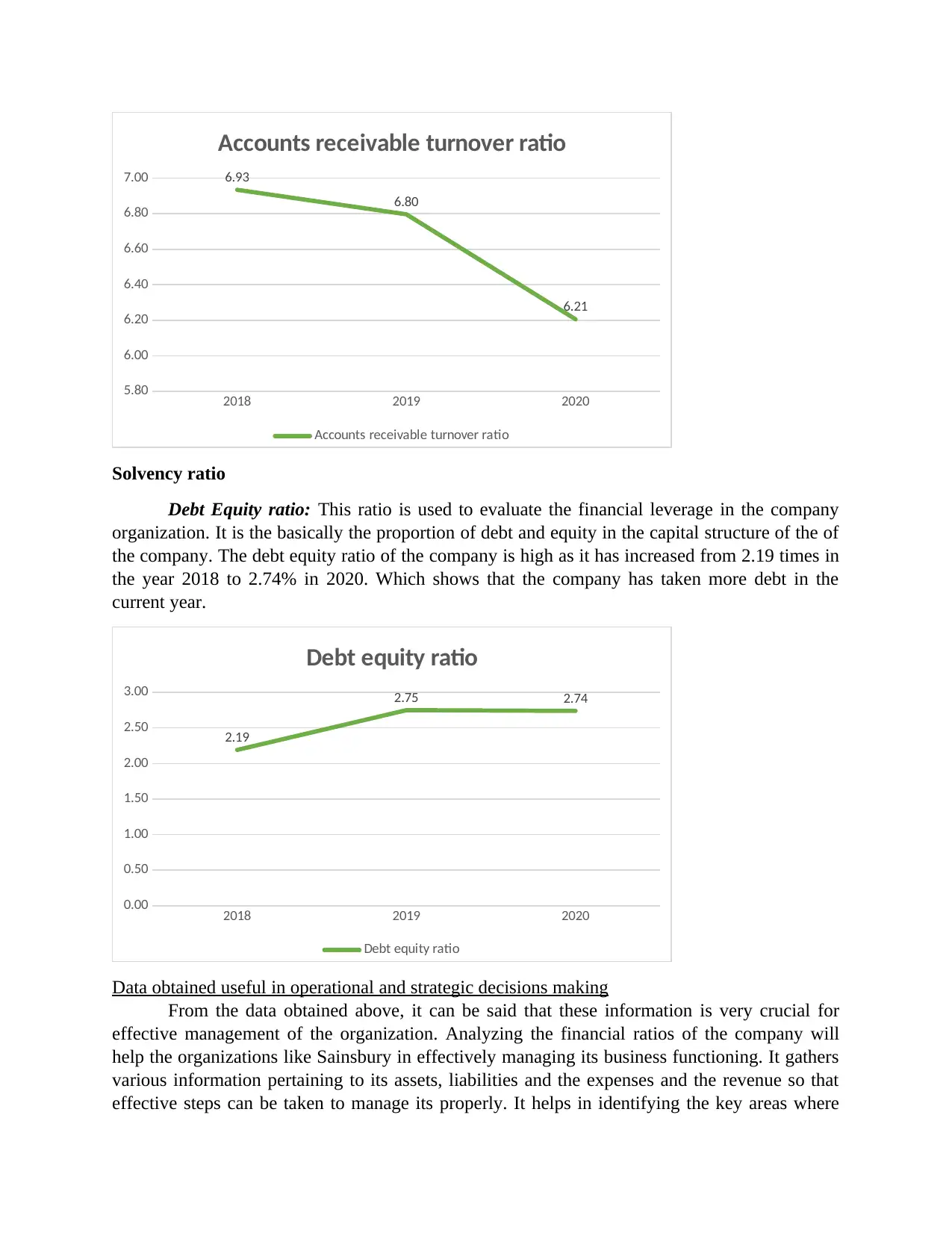
2018 2019 2020
5.80
6.00
6.20
6.40
6.60
6.80
7.00 6.93
6.80
6.21
Accounts receivable turnover ratio
Accounts receivable turnover ratio
Solvency ratio
Debt Equity ratio: This ratio is used to evaluate the financial leverage in the company
organization. It is the basically the proportion of debt and equity in the capital structure of the of
the company. The debt equity ratio of the company is high as it has increased from 2.19 times in
the year 2018 to 2.74% in 2020. Which shows that the company has taken more debt in the
current year.
2018 2019 2020
0.00
0.50
1.00
1.50
2.00
2.50
3.00
2.19
2.75 2.74
Debt equity ratio
Debt equity ratio
Data obtained useful in operational and strategic decisions making
From the data obtained above, it can be said that these information is very crucial for
effective management of the organization. Analyzing the financial ratios of the company will
help the organizations like Sainsbury in effectively managing its business functioning. It gathers
various information pertaining to its assets, liabilities and the expenses and the revenue so that
effective steps can be taken to manage its properly. It helps in identifying the key areas where
5.80
6.00
6.20
6.40
6.60
6.80
7.00 6.93
6.80
6.21
Accounts receivable turnover ratio
Accounts receivable turnover ratio
Solvency ratio
Debt Equity ratio: This ratio is used to evaluate the financial leverage in the company
organization. It is the basically the proportion of debt and equity in the capital structure of the of
the company. The debt equity ratio of the company is high as it has increased from 2.19 times in
the year 2018 to 2.74% in 2020. Which shows that the company has taken more debt in the
current year.
2018 2019 2020
0.00
0.50
1.00
1.50
2.00
2.50
3.00
2.19
2.75 2.74
Debt equity ratio
Debt equity ratio
Data obtained useful in operational and strategic decisions making
From the data obtained above, it can be said that these information is very crucial for
effective management of the organization. Analyzing the financial ratios of the company will
help the organizations like Sainsbury in effectively managing its business functioning. It gathers
various information pertaining to its assets, liabilities and the expenses and the revenue so that
effective steps can be taken to manage its properly. It helps in identifying the key areas where
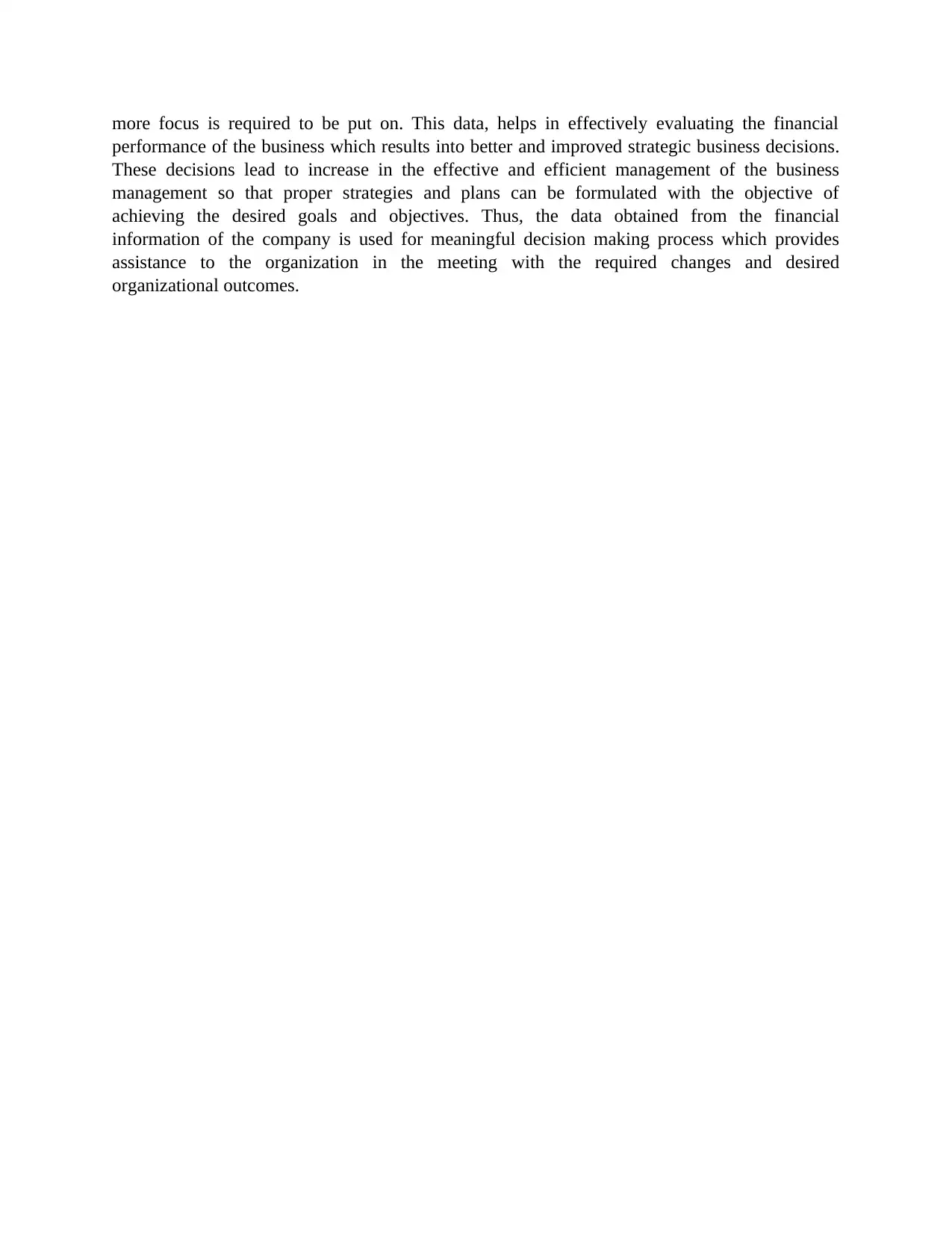
more focus is required to be put on. This data, helps in effectively evaluating the financial
performance of the business which results into better and improved strategic business decisions.
These decisions lead to increase in the effective and efficient management of the business
management so that proper strategies and plans can be formulated with the objective of
achieving the desired goals and objectives. Thus, the data obtained from the financial
information of the company is used for meaningful decision making process which provides
assistance to the organization in the meeting with the required changes and desired
organizational outcomes.
performance of the business which results into better and improved strategic business decisions.
These decisions lead to increase in the effective and efficient management of the business
management so that proper strategies and plans can be formulated with the objective of
achieving the desired goals and objectives. Thus, the data obtained from the financial
information of the company is used for meaningful decision making process which provides
assistance to the organization in the meeting with the required changes and desired
organizational outcomes.

1 out of 10
Related Documents
Your All-in-One AI-Powered Toolkit for Academic Success.
+13062052269
info@desklib.com
Available 24*7 on WhatsApp / Email
![[object Object]](/_next/static/media/star-bottom.7253800d.svg)
Unlock your academic potential
© 2024 | Zucol Services PVT LTD | All rights reserved.





